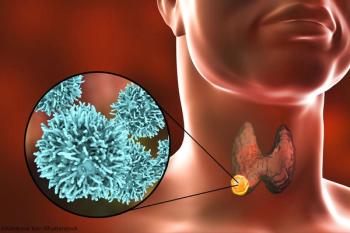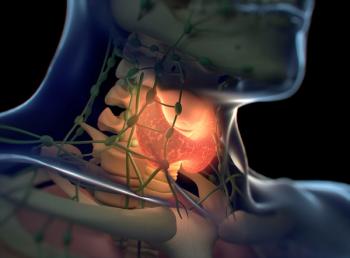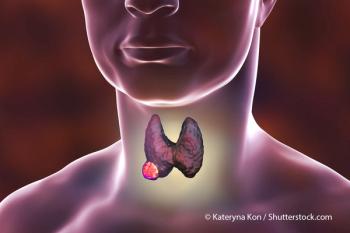
Radioguided SLNB Detected Lymph Node Mets in Thyroid Cancer
Radioguided sentinel lymph node biopsy detected occult cervical lymph node metastases in about one-half of patients with thyroid nodules suspicious for papillary thyroid carcinoma, altering the management of their disease.
Radioguided sentinel lymph node biopsy (SLNB) detected occult cervical lymph node metastases in about one-half of patients with thyroid nodules suspicious for papillary thyroid carcinoma, thus, altering management of their disease, according to the results of a study
“We observed that 37.8% of the patients would have been under-staged if only submitted to clinical evaluation and ultrasonography for primary staging, especially in the 18% of patients that had metastases in the lateral compartments,” wrote researcher Raquel Novas Cabrera, MD, of the department of radiology at the University of Campinas in Brazil, and colleagues. “SLNB avoided central compartment lymphadenectomy in 44.6% of patients.”
According to the study, patients with T1 and T2 thyroid tumors and clinically uninvolved central neck lymph nodes (cN0) are not recommended to have prophylactic central compartment neck dissection; however, these classifications are made using clinical exams and ultrasonography and often have false negative rates as high as 30%. The use of SLNB to detect lymph node metastases is one alternative to neck dissection in these patients.
In this analysis, Cabrera and colleagues evaluated SPECT/CT lymphoscintigraphy for radioguided SLNB to see if the method could detect lymph node metastases and if it changed surgical management of patients with thyroid carcinoma. They enrolled 42 patients between June 2010 and November 2013 who had nodules suspicious for cancer without suspicion of lymph node metastases by clinical and ultrasound examination. Patients underwent preoperative lymphoscintigraphy and cervical images were acquired using SPECT/CT. About 2 hours later, intraoperative radioguided SLNB occurred using a handheld gamma probe.
At least one sentinel lymph node was identified in a majority (92%) of patients. Forty-six percent of patients had metastases; 37.8% of patients had cervical sentinel lymph node metastases and 18% of patients had metastases in the lateral compartment. Three patients had false negatives.
“Our results suggest that occult metastases are unobserved and underestimated on initial staging owing to the low detection rate by ultrasonography and the lack of proper intraoperative lymph node dissection, especially in the lateral compartments,” the researchers wrote.
The researchers found that lymph node metastases were significantly associated with tumor size (odds ratio, 1.06 [95% CI, 1.00–1.13]; P = .02). About one-half of patients (46%) had disease management altered because they were submitted to higher radioiodine ablation doses and closer clinical surveillance.
“SLNB has become the most accurate investigation tool for proper staging of many cancer types, mainly with the use of SPECT/CT lymphoscintigraphy prior to surgery,” the researchers wrote. “In our study, the technique reduced the surgical time and improved surgical planning and incision based on the prior identification of lymph nodes, especially in the lateral neck compartment. SPECT/CT lymphoscintigraphy and radioguided SLNB is a procedure that is feasible and easy to perform, although slightly more costly and time-consuming, as well as not readily available in many centers.”
Newsletter
Stay up to date on recent advances in the multidisciplinary approach to cancer.
































































































